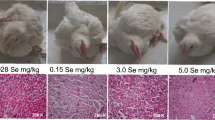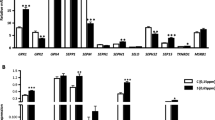Abstract
Selenium (Se) is an essential trace element in many life forms due to its occurrence as selenocysteine (Sec) residue in selenoproteins. However, little is known about the expression pattern of selenoproteins in the liver of layer chicken. To investigate the effects of Se deficiency on the mRNA expressions of selenoproteins in the liver tissue of layer chickens, 1-day-old layer chickens were randomly allocated into two groups (n = 120/group). The Se-deficient group (−Se) was fed a Se-deficient corn–soy basal diet; the Se-adequate group as control (+Se) was fed the same basal diet supplemented with Se at 0.15 mg/kg (sodium selenite). The liver tissue was collected and examined for mRNA levels of 21 selenoprotein genes at 15, 25, 35, 45, 55, and 65 days old. The data indicated that the mRNA expressions of Gpx1, Gpx2, Gpx3, Gpx4, Sepn1, Sepp1, Selo, Sepx1, Selu, Txnrd1, Txnrd2, Txnrd3, Dio1, Dio2, SPS2, Selm, SelPb, Sep15, and Sels were decreased (p < 0.05), but not the levels of Dio3 and Seli (p > 0.05). The results showed that the mRNA levels of 19 selenoprotein (except Seli and Dio3) genes in the layer chicken liver were regulated by diet Se level. The present study provided some compensated data about the roles of Se in the regulation of selenoproteins.


Similar content being viewed by others
References
Loflin J, Lopez N, Whanger PD, Kioussi C (2006) Selenoprotein W during development and oxidative stress. J Inorg Biochem 100:1679–1684
Yu D, Li JL, Zhang JL, Gao XJ, Xu S (2011) Effects of dietary selenium on selenoprotein W gene expression in the chicken immune organs. Biol Trace Elem Res 144:678–687
Naziroglu M, Karaoglu A, Aksoy AO (2004) Selenium and high dose vitamin E administration protects cisplatin-induced oxidative damage to renal, liver and lens tissues in rats. Toxicology 195:221–230
Naziroglu M, Yurekli VA (2013) Effects of antiepileptic drugs on antioxidant and oxidant molecular pathways: focus on trace elements. Cell Mol Neurobiol 33:589–599
Huang JQ, Li DL, Zhao H et al (2011) The selenium deficiency disease exudative diathesis in chicks is associated with downregulation of seven common selenoprotein genes in liver and muscle. J Nutr 141:1605–1610
Gao X, Xing H, Li S et al (2012) Selenium regulates gene expression of selenoprotein W in chicken gastrointestinal tract. Biol Trace Elem Res 145:181–188
Behne D, Kyriakopoulos A (2001) Mammalian selenium-containing proteins. Annu Rev Nutr 21:453–473
Kryukov GV, Castellano S, Novoselov SV et al (2003) Characterization of mammalian selenoproteomes. Science 300:1439–1443
Mariotti M, Ridge PG, Zhang Y et al (2012) Composition and evolution of the vertebrate and mammalian selenoproteomes. PLoS One 7:e33066
Reeves MA, Hoffmann PR (2009) The human selenoproteome: recent insights into functions and regulation. Cell Mol Life Sci CMLS 66:2457–2478
Wang R, Sun B, Zhang Z, Li S, Xu S (2011) Dietary selenium influences pancreatic tissue levels of selenoprotein W in chickens. J Inorg Biochem 105:1156–1160
Pappas AC, Zoidis E, Surai PF, Zervas G (2008) Selenoproteins and maternal nutrition. Comparative biochemistry and physiology. Part B, Biochem Mol Biol 151:361–372
Zhou JC, Zhao H, Li JG et al (2009) Selenoprotein gene expression in thyroid and pituitary of young pigs is not affected by dietary selenium deficiency or excess. J Nutr 139:1061–1066
Barnes KM, Evenson JK, Raines AM, Sunde RA (2009) Transcript analysis of the selenoproteome indicates that dietary selenium requirements of rats based on selenium-regulated selenoprotein mRNA levels are uniformly less than those based on glutathione peroxidase activity. J Nutr 139:199–206
Li JL, Ruan HF, Li HX et al (2011) Molecular cloning, characterization and mRNA expression analysis of a novel selenoprotein: avian selenoprotein W from chicken. Mol Biol Rep 38:4015–4022
Zhang J, Li J, Zhang Z et al (2012) Ubiquitous expression of selenoprotein N transcripts in chicken tissues and early developmental expression pattern in skeletal muscles. Biol Trace Elem Res 146:187–191
Burk RF, Hill KE (2005) Selenoprotein P: an extracellular protein with unique physical characteristics and a role in selenium homeostasis. Annu Rev Nutr 25:215–235
Thuluvath PJ, Triger DR (1992) Selenium in chronic liver disease. J Hepatol 14:176–182
Naziroglu M (2009) Role of selenium on calcium signaling and oxidative stress-induced molecular pathways in epilepsy. Neurochem Res 34:2181–2191
Sun B, Wang R, Li J, Jiang Z, Xu S (2011) Dietary selenium affects selenoprotein W gene expression in the liver of chicken. Biol Trace Elem Res 143:1516–1523
Liu Y, Zhao H, Zhang Q et al (2012) Prolonged dietary selenium deficiency or excess does not globally affect selenoprotein gene expression and/or protein production in various tissues of pigs. J Nutr 142:1410–1416
Burk RF (1991) Molecular biology of selenium with implications for its metabolism. FASEB: Off Publ Fed Am Soc Exp Biol 5:2274–2279
Hill KE, Lyons PR, Burk RF (1992) Differential regulation of rat liver selenoprotein mRNAs in selenium deficiency. Biochem Biophys Res Commun 185:260–263
Bermano G, Nicol F, Dyer JA et al (1995) Tissue-specific regulation of selenoenzyme gene expression during selenium deficiency in rats. Biochem J 311(Pt 2):425–430
Sunde RA, Hadley KB (2010) Phospholipid hydroperoxide glutathione peroxidase (Gpx4) is highly regulated in male turkey poults and can be used to determine dietary selenium requirements. Exp Biol Med (Maywood) 235:23–31
Hrdina J, Banning A, Kipp A et al (2009) The gastrointestinal microbiota affects the selenium status and selenoprotein expression in mice. J Nutr Biochem 20:638–648
Sunde RA, Raines AM, Barnes KM, Evenson JK (2009) Selenium status highly regulates selenoprotein mRNA levels for only a subset of the selenoproteins in the selenoproteome. Biosci Rep 29:329–338
Hill KE, McCollum GW, Boeglin ME, Burk RF (1997) Thioredoxin reductase activity is decreased by selenium deficiency. Biochem Biophys Res Commun 234:293–295
Hostetler CE, Michal J, Robison M, Ott TL, Kincaid RL (2006) Effect of selenium intake and fetal age on mRNA levels of two selenoproteins in porcine fetal and maternal liver. J Anim Sci 84:2382–2390
Berry MJ, Banu L, Larsen PR (1991) Type I iodothyronine deiodinase is a selenocysteine-containing enzyme. Nature 349:438–440
Arthur JR, Nicol F, Beckett GJ, Trayhurn P (1991) Impairment of iodothyronine 5′-deiodinase activity in brown adipose tissue and its acute stimulation by cold in selenium deficiency. Can J Physiol Pharmacol 69:782–785
Korotkov KV, Kumaraswamy E, Zhou Y, Hatfield DL, Gladyshev VN (2001) Association between the 15-kDa selenoprotein and UDP-glucose:glycoprotein glucosyltransferase in the endoplasmic reticulum of mammalian cells. J Biol Chem 276:15330–15336
Lin L, Zhou W, Dai H et al (2012) Selenium reduces cadmium uptake and mitigates cadmium toxicity in rice. J Hazard Mater 235–236:343–351
Yeh MS, Huang CJ, Guo CH et al (2012) Identification and cloning of a selenophosphate synthetase (SPS) from tiger shrimp, Penaeus monodon, and its transcription in relation to molt stages and following pathogen infection. Dev Comp Immunol 36:21–30
Xu XM, Carlson BA, Mix H et al (2007) Biosynthesis of selenocysteine on its tRNA in eukaryotes. PLoS Biol 5:e4
Costa FC, Oliva MA, de Jesus TC, Schenkman S, Thiemann OH (2011) Oxidative stress protection of Trypanosomes requires selenophosphate synthase. Mol Biochem Parasitol 180:47–50
Novoselov SV, Kryukov GV, Xu XM et al (2007) Selenoprotein H is a nucleolar thioredoxin-like protein with a unique expression pattern. J Biol Chem 282:11960–11968
Guariniello S, Colonna G, Raucci R et al (2014) Structure–function relationship and evolutionary history of the human selenoprotein M (SelM) found over-expressed in hepatocellular carcinoma. Biochim Biophys Acta 1844:447–456
Hill KE, Chittum HS, Lyons PR, Boeglin ME, Burk RF (1996) Effect of selenium on selenoprotein P expression in cultured liver cells. Biochim Biophys Acta 1313:29–34
Messaoudi I, Banni M, Said L, Said K, Kerkeni A (2010) Involvement of selenoprotein P and GPx4 gene expression in cadmium-induced testicular pathophysiology in rat. Chem Biol Interact 188:94–101
Zeng MS, Li X, Liu Y et al (2012) A high-selenium diet induces insulin resistance in gestating rats and their offspring. Free Radic Biol Med 52:1335–1342
Acknowledgments
This work was supported by the Graduate innovative research project in Heilongjiang Province China (No. YJSCX-005HLJ), China Postdoctoral Science Foundation (No. 2012 M520702), And Startup Foundation for Doctors of Northeast Agricultural University, China (No. 2012RCB92).
Author information
Authors and Affiliations
Corresponding author
Additional information
All other authors have read the manuscript and have agreed to submit it in its current form for consideration for publication in the journal.
Rights and permissions
About this article
Cite this article
Liu, C.P., Fu, J., Lin, S.L. et al. Effects of Dietary Selenium Deficiency on mRNA Levels of Twenty-One Selenoprotein Genes in the Liver of Layer Chicken. Biol Trace Elem Res 159, 192–198 (2014). https://doi.org/10.1007/s12011-014-0005-9
Received:
Accepted:
Published:
Issue Date:
DOI: https://doi.org/10.1007/s12011-014-0005-9




